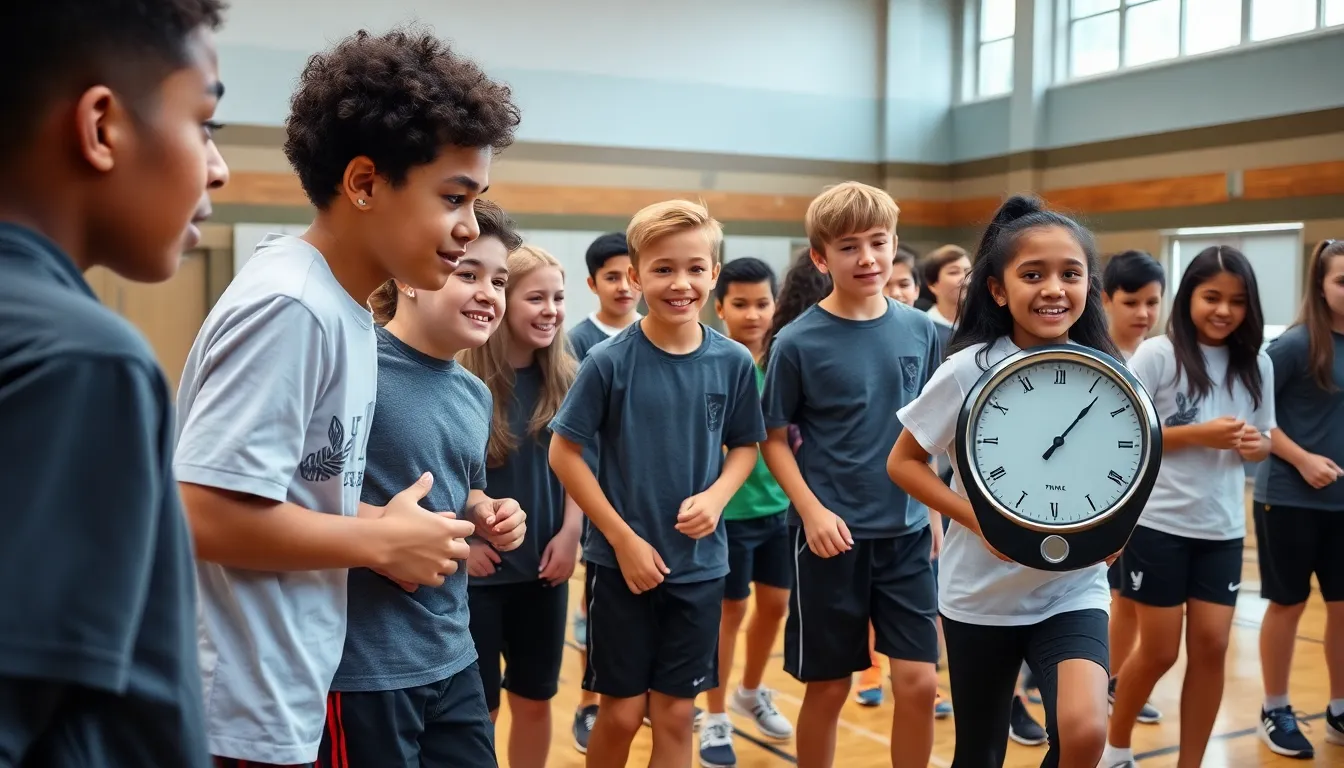The Fitness Gram Pacer Test isn’t just another exercise; it’s a rite of passage for many school kids. This legendary endurance test has become infamous for its catchy phrases and relentless beep. It’s like a game of musical chairs, but instead of chairs, you’re racing against your own stamina. Who knew running back and forth could sound so dramatic?
Table of Contents
ToggleOverview of the Fitness Gram Pacer Test
The Fitness Gram Pacer Test serves as a vital endurance assessment for school-aged children. This test combines physical fitness with memorable moments, creating a unique experience for participants.
Purpose of the Test
The main goal of the Fitness Gram Pacer Test focuses on assessing cardiovascular endurance. It encourages children to improve their aerobic capacity through a fun, engaging format. As students run back and forth in time with a beeping sound, they push their limits while enjoying a competitive atmosphere. This test also helps promote lifelong fitness habits by introducing children to endurance training. Schools utilize this test as a benchmark to track fitness progress over time, aiming to motivate students to achieve their personal best.
Structure of the Test
The Fitness Gram Pacer Test consists of a series of 20-meter shuttle runs. Participants start at one end of the designated area. A beep signals the start, prompting them to run to the opposite end before the next beep. Each successive beep occurs at shorter intervals, increasing the challenge. Students often compete with themselves and their peers, striving to reach as many laps as possible. The test concludes when a participant fails to reach the end before two consecutive beeps. This structured approach allows students to gauge their endurance levels effectively while fostering a spirit of camaraderie among classmates.
Importance of Vocabulary in Fitness Tests

Vocabulary plays a crucial role in fitness tests like the Fitness Gram Pacer Test. Understanding specific terms enhances comprehension and performance.
Common Terms Used
Key phrases such as “shuttle run,” “beep,” and “endurance” surface frequently during the Pacer Test. “Shuttle run” describes the specific distance runners cover, while “beep” refers to the auditory cue indicating when to run. “Endurance” highlights the primary focus of the test: assessing cardiovascular stamina. Terms like “aerobic capacity” and “fitness benchmark” also contribute to understanding the overall objectives of the test. Grasping these common terms allows students to engage effectively, leading to greater participation and motivation.
Understanding Fitness Terminology
Fitness terminology provides clarity and context within tests. Learning terms like “cardiovascular endurance” directly relates to the test’s purpose of gauging heart and lung efficiency. “Pacer” signifies pacing oneself throughout the test. This understanding encourages students to develop personal strategies for improvement. Familiarity with terms also helps in discussing performance with peers and teachers. As fitness vocabulary becomes second nature, participants build confidence, enhancing their overall experience during the test. Understanding these terms bridges the gap between instruction and execution.
Sample Words from the Fitness Gram Pacer Test
The Fitness Gram Pacer Test encompasses a variety of words that enhance understanding and engagement. Familiarity with specific vocabulary aids participants in grasping the test’s objectives and expectations.
Descriptive Words
Descriptive words encapsulate the essence of the Fitness Gram Pacer Test. Key terms include endurance, which signifies the ability to sustain exercise over time, and progressive, relating to the increasing intensity of the test. Cardiovascular describes the heart and lungs’ performance during activity. Participants experience challenging conditions that push their limits. Competitive reflects the nature of the test, motivating students to strive for their personal best. Memorable points to the lasting impressions left by the test, often shared among peers. Each of these words contributes to the overall comprehension of the test experience.
Action Words
Action words energize the Fitness Gram Pacer Test, guiding participants through the necessary movements. Terms such as run signal the main activity required during the test. Participants must accelerate as they adapt to increasing beep frequencies. The word pace emphasizes the importance of maintaining a consistent speed. Challenge indicates the competitive spirit among peers, encouraging camaraderie. Lastly, improve drives participants to reach higher fitness levels, reinforcing personal growth objectives. Action words not only clarify expectations but also inspire active participation.
Benefits of Familiarity with Fitness Language
Familiarity with fitness terminology greatly enhances the performance and engagement of participants during the Fitness Gram Pacer Test.
Enhancing Test Performance
Understanding key fitness phrases like “shuttle run” and “endurance” leads to improved execution of the test. Participants who recognize these terms demonstrate greater awareness of their goals, resulting in more effective training strategies. When students grasp the meaning behind words like “aerobic capacity” and “cardiovascular endurance,” they can approach the test with a targeted mindset. Knowledge of specific vocabularies boosts confidence, which often translates into better performance on test day. Consequently, accuracy in movement and pacing increases, allowing students to maximize their potential.
Encouraging Participation
Familiarity with fitness language also plays a significant role in motivating students to engage actively in the Fitness Gram Pacer Test. Recognizing descriptive terms such as “competitive” and “memorable” creates a positive association with the experience. A clear understanding of the test components encourages students to participate willingly and enthusiastically. Knowing action words like “improve” and “challenge” inspires a sense of ownership over personal fitness journeys. With this vocabulary, they feel equipped to take part, fostering an environment where students support each other in achieving their best. Ultimately, a strong foundation in fitness language elevates the overall participation experience.
The Fitness Gram Pacer Test stands out as more than just a physical assessment; it’s an engaging experience that shapes students’ attitudes toward fitness. Understanding the vocabulary associated with the test enhances participants’ confidence and performance. By familiarizing themselves with key terms, students can approach the challenge with clarity and purpose.
This connection between language and fitness fosters a supportive environment where students motivate each other. As they learn to embrace endurance and improvement, they also cultivate lifelong habits that extend beyond the classroom. Ultimately, the Fitness Gram Pacer Test not only measures physical ability but also inspires a community of fitness-minded individuals ready to take on new challenges.



